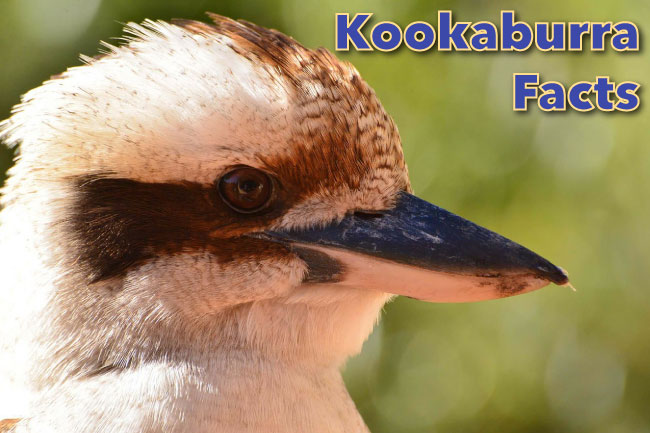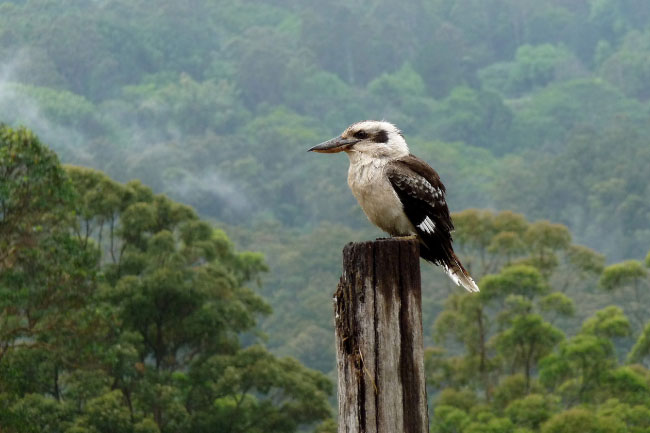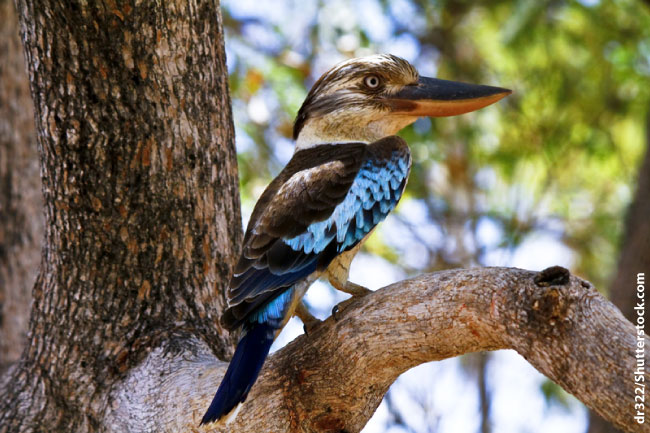The Kookaburra is a member of the Tree Kingfisher family. It is famous for having a loud call that sounds like human laughter. The Kookaburra also features in a popular Australian children’s song. This article contains kookaburra facts for kids and adults, and is part of our Australian Animals series.
Don’t forget to listen to the Kookaburra’s famous laugh! You can hear it in a video further down the page.
Top Kookaburra Facts for Kids
- There are four species of Kookaburra
- Despite its name, the Shovel-Billed Kookaburra (Clytoceyx rex) is in a different genus.
- Kookaburras all have long bills, which can grow up to 4 in (10 cm) long.
- Although Kookaburras are in the ‘Tree Kingfisher’ family, they don’t need to live near water and fish isn’t a major part of their diet.
- Kookaburras are the largest of all the kingfishers.
- Although well-known for being an Australian bird, Kookaburras are also found in New Guinea.
- Kookaburras are famous for their call, which sounds like laughter (you can hear it further down the page).
- Groups of Kookaburras often call loudly at dawn and dusk. The birds' calls are known as the ‘Bushman’s Clock’.
- All Kookaburras are rated as being of ‘Least Concern’ on the IUCN Red List.
- Kookaburras have learned to live alongside humans, and are often seen in suburban areas.
- Kookaburras have been known to prey on chicks and ducklings on farms.
- The Kookaburra features in the popular children's song, 'Kookaburra Sits In The Old Gum Tree'. You can read more about the song at this Wikipedia page.
Kookaburra Facts: Introduction
There are four species of kookaburra:
- Rufous-Bellied Kookaburra (Dacelo gaudichaud)
- Spangled Kookaburra (Dacelo tyro)
- Blue-Winged Kookaburra (Dacelo leachii)
- Laughing Kookaburra (Dacelo novaeguineae)
Another bird, the Shovel-billed Kookaburra (Latin name Clytoceyx rex), is in the same family as the kookaburras but despite its name is not in the same genus.
Animal Expert fact: You can tell an animal's genus by looking at the first word of its scientific name. For example, the Laughing Kookaburra's scientific name is 'Dacelo novaeguineae'. Therefore its genus is 'Dacelo'.
Australian Kingfisher
Kookaburras are members of the Halcyonidae family. This family of birds is part of a larger group of birds known as the Kingfishers.
Birds in the Halcyonidae family are known as ‘Tree Kingfishers’.
Kookaburras are the largest kingfishers.
Meat Eaters!
Unlike some other members of the kingfisher group, kookaburras do not have to live by water. They live and feed in forests. Fish do not form a major part of their diet. All kookaburras are mainly carnivorous (meat eaters). They eat a range of animals, from insects to snakes.
Although kookaburras are known for being an Australian bird, only the blue-winged and Laughing Kookaburras are found in Australia. The other two species are also found in New Guinea.
Physical Description
All four kookaburras have a similar build. All are reasonably large birds. They have short, rather round bodies, and short tails. The most striking thing about a kookaburra is its big bill.
Laughing Kookaburra (Dacelo novaeguineae)
The Laughing Kookaburra is the best-known Kookaburra. It is found in eastern Australia, including Tasmania. It is also found in southwest Australia after having been introduced there in the late 19th century.
The laughing kookaburra has a pale head and chest, with dark wings and tail feathers. It has a long dark patch over its eyes, and of course, a long, powerful-looking bill.
There is some blue on its wings, but not as much as the blue-winged kookaburra.
Watch laughing kookaburras in Australia in the video below:
You can hear the Laughing Kookaburra's famous laugh further down the page.
Blue-Winged Kookaburra (Dacelo leachii)
The blue-winged kookaburra is found across northern Australia. It is slightly smaller than the laughing kookaburra. As its name suggests, the Blue-Winged Kookaburra has beautiful blue wings. Males also have blue tails, and females have red-brown tails.
Rufous-Bellied Kookaburra (Dacelo gaudichaud)
Rufous-Bellied kookaburras are found in New Guinea and nearby islands. They have blue wings and red-brown chests.
Spangled Kookaburra (Dacelo tyro)
Spangled kookaburras have white chests, and blue wings and tails. They are found in New Guinea and some nearby islands.
Shovel-billed Kookaburra (Clytoceyx rex)
Shovel-billed Kookaburras have very distinctive thick bills. They have dark heads and backs, with dull red chests and a red stripe around the back of their necks. They only live in New Guinea.
Kookaburra Habitat
Kookaburras live in a variety of habitats, from forests to savannas.
Kookaburra Diet and Hunting
Kookaburras are carnivorous, and have a varied diet. They will eat insects, small mammals, lizards and even venomous snakes.
Kookaburras perch on branches and wait for their prey to approach. When the prey is in range, they swoop down and grab it in their big beaks.
The Kookaburra’s Laugh
The kookaburra’s laugh is a familiar sound in Australian woodlands and forests. It is used to mark and protect the bird’s territory. Groups of kookaburras often start laughing at the same time, making an unforgettable din!
Listen to the kookaburra’s laugh in the video below.
Are Kookaburras Endangered?
All of the kookaburras are rated as being of ‘Least Concern’ in the IUCN Red List. All native wildlife is protected by Australian law. However, any future habitat loss would threaten the kookaburras.
Kookaburra Facts For Kids Conclusion
We hope that you have enjoyed learning all about Kookaburras. If you’re lucky enough to live near Kookaburras, we hope that you appreciate these fierce (if you’re a small animal) but beautiful birds even more.
You can find out about more amazing Australian animals here.







